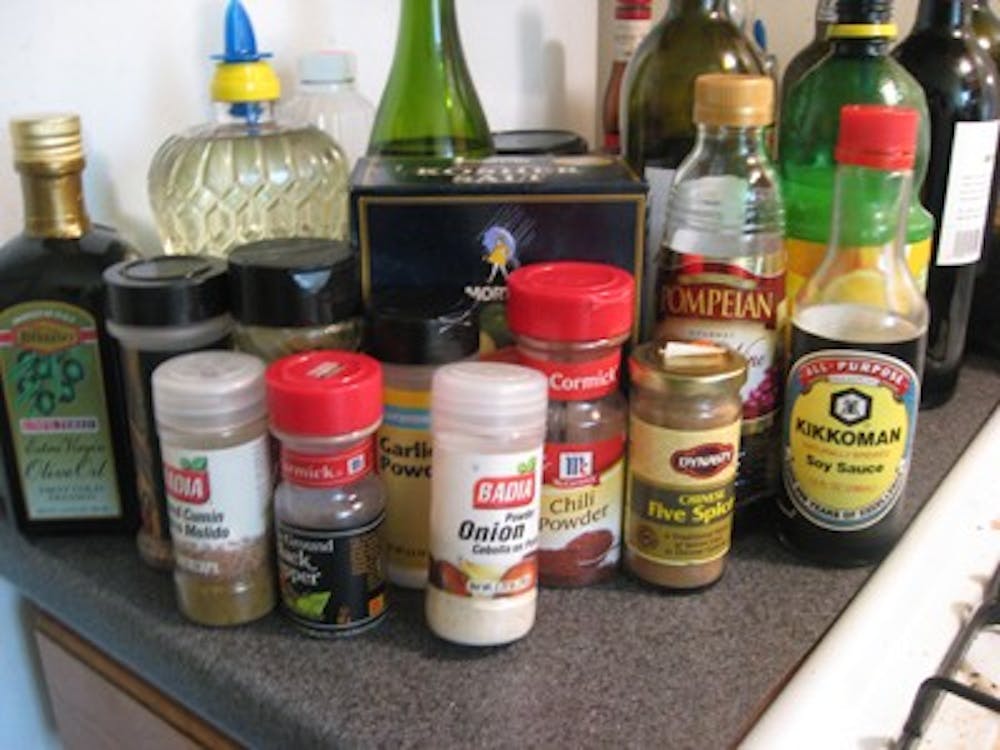One of the things I love most about cooking is being able to throw together something tasty based on stuff that I have lying around. While the ingredients in my fridge tend to vary, there are a few staples that, for me, help facilitate this spontaneous cooking process.
Oils
I try to keep two oils on hand at all times: a regular canola oil and a good (as good as I can afford) extra virgin olive oil. I use the canola oil in 90 percent of my cooking — everything from sautés to salad dressings.
Why? It’s got a clean, neutral flavor and a high smoke point. Neutral just means that it doesn’t overpower whatever I’m using it in, and the high smoke point means that it can take lots of heat without breaking down.
I use the olive oil sparingly — it has a great flavor, but it’s just a little too strong for most things. My rule of thumb is that I don’t use it unless I want to taste it.
Acids
Acidity in a dish is essential to achieve a balanced flavor. Aside from being one of the five basic tastes (the other four being salty, sweet, bitter and savory), acidity helps strip the palate of other flavors and prepares it for the next taste. For that reason, I generally keep a wide variety on hand: red and white wines, lemon and lime juices and all sorts of vinegars.
Salt and pepper
Salt is probably the most ubiquitous ingredient in the world. I can’t imagine life without it. I’m not sure if it really makes a difference, but I prefer kosher salt to regular table salt. It’s definitely a little bit coarser, which I think makes it easier to sprinkle evenly.
Of course, you’re very rarely going to use salt without pepper. In fact, some cooks will keep a blend of salt and pepper on hand for convenience. For super-fresh pepper, buy peppercorns and a cheap coffee grinder and grind small batches once a week or so. The next best thing is the coarse ground, which seems to stay fresher longer and pack more of that peppery punch.
Spices
There are about 10 spices and spice blends that I use on a regular basis: red chili flakes, cayenne pepper, dry mustard, garlic powder, onion powder, cumin, oregano, chili powder, five-spice powder and bay leaf.
I use chili flakes for a more subtle, “back-of-the-mouth” kind of heat. The cayenne pepper is much more direct and in-your-face.
Mustard powder is fantastic in stir-fries and barbecue. It goes with pork like peanut butter goes with jelly.
Garlic and onion powders are great for spice rubs (which I generally prefer to liquid marinades). I use them in barbecue and Latin-style recipes. They also work well for last minute adjustments in my marinara and Bolognese sauces if I feel like they need a little more flavor.
Cumin is a staple in Latin American, Mediterranean and Indian cuisines. I use a lot of it in hummus and rice and beans.
Contrary to what you might think, chili powder isn’t spicy (well, not “hot” spicy). It gives dishes a sweet, almost smoky flavor. Like the garlic and onion powders, I use it in my barbecue spice, and some (but not all) Latin-style dishes.
I use five-spice less frequently than most of the others, but it’s great for sweet-and-sour type stir-fries, and it also works well as a substitute for cinnamon (think apple pie) when you want to add a little more complexity to a dish.
Bay leaves add a very distinct and subtle flavor to almost anything. I toss one or two into anything I boil or simmer — beans, tomato sauce, stews, etc. I’ve seen them used in every cuisine from Mexican to French, Italian and even Indian.
Other flavors
Mirin (Chinese cooking wine) and soy sauce are essential if you do any sort of Asian cooking. If you do a lot of it, you might also want to pick up a bottle of sesame oil.
Onions and garlic end up in 90 percent of the dishes that I cook. I usually keep one white onion and one red onion on hand. I use whole garlic and chop as I need it; the prechopped stuff always has a funky smell to it.
Putting it together
So here’s an example of putting these essentials to good use: I got home late from work one night, and, after decompressing with an adult beverage, I started to get hungry.
I looked in my fridge and discovered some diced pork, some corn tortillas, a piece of jalapeño pepper and a bunch of cilantro.
I tossed the pork in a bowl with some canola oil, salt, pepper, chili flakes, chili powder, garlic powder and onion powder. After some deliberation, I added just a little bit of diced jalapeño and let it marinate while I heated a pan on the stove. When the pan was good and hot, I tossed the meat in and let it sear while I washed a few dishes.
I flipped the meat, let it cook for another minute then took it off the heat and deglazed the pan with some lemon and lime juices. I let it all sit for a minute while I heated the tortillas directly over the burner, and in less than the time it would have taken me to get to McDonald’s and back, I had an easy and tasty plate of tacos.
You can reach this columnist at thescene@theeagleonline.com.





